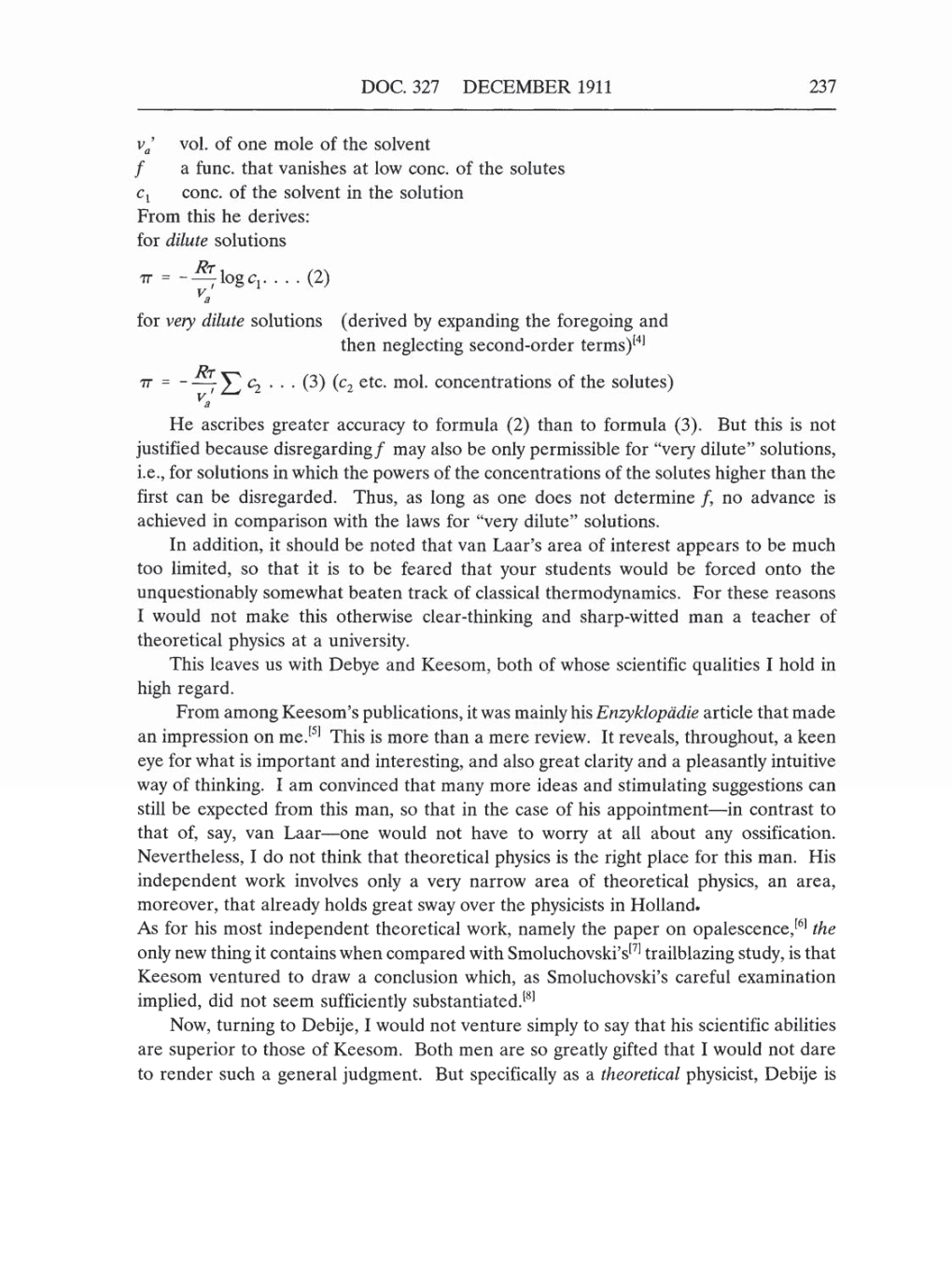DOC.
327
DECEMBER
1911 237
va'
vol.
of
one
mole
of the
solvent
f
a
func.
that vanishes
at
low
conc.
of the
solutes
c1
conc.
of the
solvent in
the solution
From
this he derives:
for dilute
solutions
TT =
-Rv'alogC1
....
(2)
for
very
dilute
solutions
(derived
by
expanding
the
foregoing
and
then
neglecting
second-order
terms)[4]
Rr
77- =
--v'ac2
...
(3)
(c2
etc.
mol.
concentrations of the
solutes)
He
ascribes
greater
accuracy
to
formula
(2)
than
to
formula
(3).
But
this
is not
justified
because
disregardingf
may
also be
only permissible
for
"very
dilute"
solutions,
i.e.,
for
solutions
in which
the
powers
of the
concentrations of
the solutes
higher
than the
first
can
be
disregarded. Thus,
as
long
as one
does not
determine
f,
no
advance
is
achieved in
comparison
with the laws
for
"very
dilute"
solutions.
In addition, it
should
be
noted that
van
Laar's
area
of
interest
appears
to be much
too
limited,
so
that
it
is
to be
feared that
your
students
would be
forced
onto
the
unquestionably
somewhat beaten track of
classical
thermodynamics.
For these
reasons
I would not
make
this
otherwise
clear-thinking
and
sharp-witted
man
a
teacher of
theoretical
physics
at
a
university.
This leaves
us
with
Debye
and
Keesom,
both
of whose scientific
qualities
I hold in
high
regard.
From
among
Keesom's
publications,
it
was
mainly
his
Enzyklopädie
article that
made
an
impression
on
me.[5]
This
is
more
than
a mere
review. It
reveals, throughout,
a
keen
eye
for
what
is
important
and
interesting,
and
also
great
clarity
and
a
pleasantly
intuitive
way
of
thinking.
I
am
convinced
that
many more
ideas and
stimulating
suggestions
can
still
be
expected
from
this
man,
so
that
in the
case
of
his appointment-in contrast
to
that
of, say,
van
Laar-one
would
not
have to
worry
at
all
about
any
ossification.
Nevertheless,
I
do
not
think that theoretical
physics
is
the
right place
for
this
man.
His
independent
work
involves
only a very
narrow area
of theoretical
physics, an
area,
moreover,
that
already
holds
great
sway
over
the
physicists
in
Holland.
As for his
most
independent
theoretical
work,
namely
the
paper
on opalescence,[6]
the
only
new
thing
it
contains when
compared
with Smoluchovski's[7]
trailblazing
study,
is
that
Keesom
ventured
to
draw
a
conclusion
which,
as
Smoluchovski's
careful examination
implied,
did
not
seem
sufficiently
substantiated.[8]
Now,
turning
to
Debije,
I would not venture
simply
to
say
that
his scientific abilities
are
superior to
those of
Keesom. Both
men are so
greatly gifted
that
I
would not
dare
to
render
such
a
general judgment.
But
specifically
as a
theoretical
physicist,
Debije is
